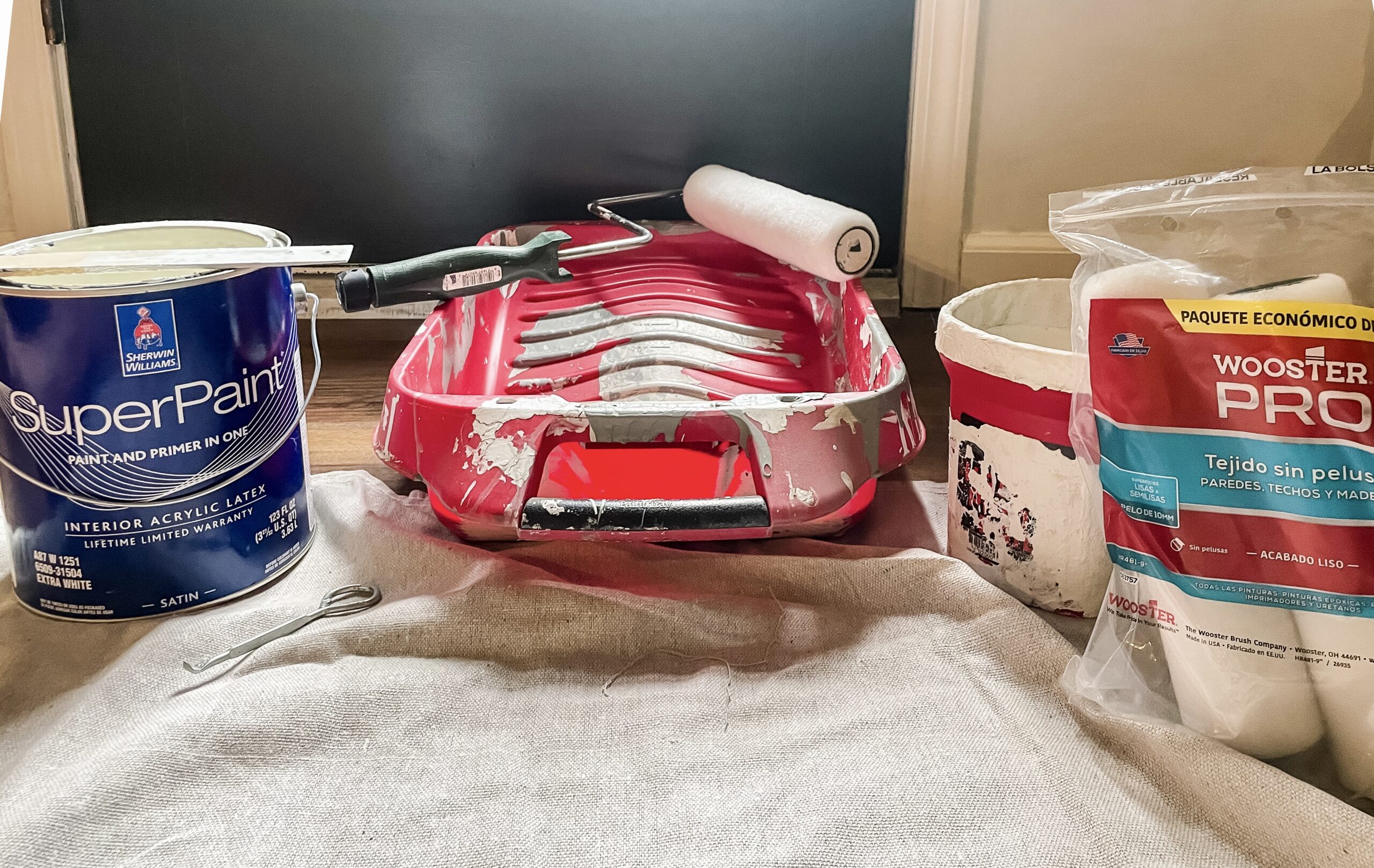
You plan to paint something- a room, cabinets, the floor… the possibilities are endless. But how do you know what tools you’ll need for the job? Sure, you can buy whatever you see first and chance trusting the marketing strategies of big box stores. Or, you can go shopping informed and knowing exactly which tools work best for your job. Read on to discover your complete guide to paint supplies.
Throughout countless DIY projects over the past 2 years (enough to fill almost 100 blog posts!) I have painted just about anything and everything. I have discovered which tools work best, and why. I’ve painted:
This post contains affiliate links for your convenience which may reward me in the event of a sale. Note that I only recommend tools and products I have personally used and loved.












Phew! That’s quite a list, makes me tired just thinking about it. There are very few surfaces in this house that paint hasn’t transformed. And in the process, very few paint supplies I haven’t tried.
To start off sharing everything I’ve learned, I’ll talk about how to paint your basic interior walls, and how to choose the right tools for the job.
Paint Supplies #1: Paintbrushes, Rollers & Sprayers
First, let’s talk about paintbrushes. They make all sorts of different shapes and sizes of paintbrushes. They are sold at different price points as well. I will share my personal favorite brush and brand for cutting in (Wooster short cut), but otherwise choosing a brand is up to you! But I do have information on sizing. So how do you know which one is best for the job?

As far as size goes, I’ll give you a general guide to help decide how many inches of brush are best for which jobs. 1″ brushes are typically best for small, tight corners, wood trim, or painting furniture legs. 1 1/2 inch brushes are best for paining window frames and moldings. 2″ brushes are good for cutting in edges, baseboards, stairs, railings, cabinets, and larger furniture surfaces. 2 1/2″ brushes are larger, and great for painting fences, gates, columns, beams, and posts. And last, brushes that are 3″ + are good for large surfaces such as painting siding, walls, doors, and ceilings.
*Disclaimer: Most of the things that 3″+ brushes are good for, are also surfaces that can be rolled, and probably more efficiently.
Paint Rollers
The next paint supplies are paint rollers. These can make your painting jobs much more efficient, and can be great for large surfaces like interior walls. They are sold in different size naps which can be used for different projects. Starting from smallest to largest, let’s figure out which size is best for your project.
1/8″ nap is the smallest, and typically best for smaller projects like painting furniture. The smaller the nap, the less paint the roller holds. Next up is the 3/8″ nap, which is the most versatile and commonly used for smooth drywall surfaces. 3/8″ is also best when applying primer. I typically use these for any interior wall painting projects.

1/2″ nap is next, and holds a bit more paint which can be helpful for textured drywall surfaces, or ceilings. Last and largest are the 3/4″ and the 1″ nap rollers, which is best for heavily textured surfaces such as stucco, brick, and crevices that are hard to coat.
Paint Sprayers
Last but not least, what’s the deal with paint sprayers? Paint sprayers require significant prep work, more paint supplies like PPE (personal protective equipment) and clean up. Traditionally, I do very little paint prep. My first time using the paint sprayer was to paint my unfinished wooden garage walls white and the cabinets navy.

I chose the Graco 360 paint sprayer because you don’t have to thin your paint, thus saving time. I would recommend using a paint sprayer over a roller, or a brush when painting intricate or larger surfaces. Paint sprayers also provide a near perfect finish. So if you don’t want brush strokes or the roller “stipple” left behind, I would recommend using a paint sprayer.
Kitchen cabinets are a surface I would want a professional and nearly perfect finish on. That is only achieved with a paint sprayer. However, if you’ve been around long you know I also tend to feel strongly about keeping wooden cabinetry in the kitchen to bring warmth (and even organized five reasons to persuade you). But, I have painted a good deal of cabinets elsewhere around my house (bathroom, garage, pop up camper…).

Paint sprayer pros include better coverage and unmatched application speed, while cons are prep work, cleaning, and cost. However, sometimes it’s the right tool for the job. When it is, using this paint supply is worth it.
Paint Supplies #2: Paint Finishes
There are two kinds of paint- latex and oil based. Latex is also known as water based, so paint spills and brushes can be cleaned up using water alone. Oil based paint has stronger fumes, longer dry time but more durability. Oil based paint cannot be painted over with latex paint ( it will cause peeling), and requires mineral spirits or paint thinner to clean up.
For most interior paint projects, I recommend using latex paint. Next, you have to choose your finish. The hierarchy from matte to shiny is as follows:
-Flat
Flat = matte. Flat paint provides a smooth finish, hides imperfections on the surface, is not reflective, but can be hard to clean. I recommend using flat paint on ceilings, in formal dining rooms, or adult bedrooms. I would not recommend using flat paint anywhere kids or pets are involved, due to the lack of durability and ability to clean.
-Eggshell
Eggshell has a subtle sheen, and can be great for low traffic areas. It is my favorite paint finish, and is in every interior wall of my home. I’ve had no trouble using a Magic Eraser to wipe off scuffs and dirt. I would recommend use on living room walls, bedrooms, and dining rooms.
FYI- Sherwin Williams does not have Eggshell- satin is what you will get.
-Satin
Satin paint is probably the most versatile, and falls right in the middle of the paint sheen spectrum. It’s easy to wipe clean, and I would recommend use in kitchen, dining rooms, bedrooms, hallways, living rooms, family rooms, or laundry rooms. Basically, this finish could be used anywhere. I used satin on all of my interior trim and doors.
-Semi-gloss
Semi-gloss paint reflects even more light, and has a higher sheen than satin. The more reflective the finish, the more noticeable imperfections on your surface will. It can be “scrubbed”, so it is durable. I recommend using this finish on trim, molding, doors, bathrooms, and kitchen cabinets.
-High gloss
High gloss = shiny. This paint is ideal for “high traffic” areas, and is still scrubbable like semi-gloss. I probably wouldn’t use this finish, but if you like the shiny look it would be a good choice for trim, molding, doors, cabinets, and utility rooms.
The higher the sheen, the more reflective and durable. Paint at a higher sheen is typically easier to clean. However, paint at a lower sheen is better at hiding imperfections. Paint finish is based on personal preference, but all my interior walls are Eggshell, and doors and trim are Satin. But what about chalk paint?
Paint Supplies: Chalk Paint
I know you’ve heard of chalk paint, if not even tried it yourself by now. However, I noticed I was overwhelmed with the amount of brands, color options and price tags for traditional chalk paint (think Annie Sloan, Rustoleum, etc.). I found this product on Amazon– basically its a powder that you can mix into any type of interior water based paint to turn it into “chalk style paint”. For me, this was a win/win based on the price point, customization options and the fact that I had all kinds of interior latex paint already on hand.

Chalk paint is great for providing excellent coverage, hiding brush strokes, and requires minimal prep work. No sanding or priming necessary. I think it’s a great option for painting wooden furniture, or things you want a durable yet matte finish on. Chalk paint does not have to be farmhouse chic, or “chippy”. It can provide an even finish, and be versatile with any decorating style especially using this Chalk-Tique additive.
I hope this guide has answered all your burning paint questions, and makes you feel confident when choosing the best tool for the job. The power of paint is unmatched, and is always my first recommendation when wanting to change or update a space. Let me know if you have any questions!






